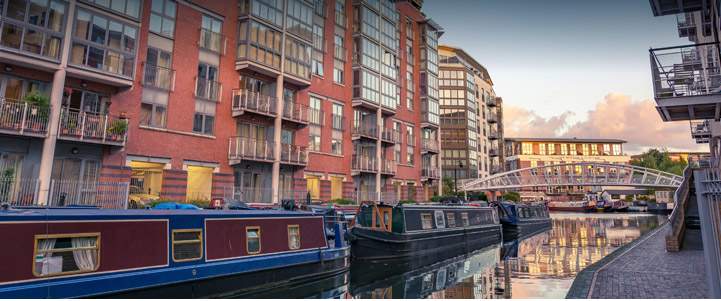Levelling Up can create opportunities for growth in Birmingham, but a more joined-up approach is needed
The Levelling Up agenda and the investment which it brings can create opportunities for growth, and Birmingham is well-placed to take advantage of these. The city will receive more than £50 million in funding through the first round of the Levelling Up fund, second only to Stoke-on-Trent, and is likely to be rewarded in the second round of funding as well.
Connectivity is a key issue which Levelling Up funding in Birmingham should seek to tackle. The West Midlands Combined Authority is home to 2.94 million people, making it the UK’s largest urban area outside of London. 1.14 million live in the city of Birmingham. The city should therefore benefit from strong agglomeration economies, where knowledge and ideas are shared by those in close proximity, prompting innovation and growth. Birmingham fails to maximise these benefits, and is, therefore, less productive, because poor connectivity reduces the functional size of the city. Just 478,000 people can commute into the centre of Birmingham in half an hour or less.
This effective population is much more similar to that of Manchester (456,000), Liverpool (404,000) and Newcastle (402,000). Investment in transport infrastructure which allows more people to access the hubs of economic activity in the West Midlands should increase the strength of agglomeration economies and positively impact economic growth.
Attracting new employees
Densification may form part of a solution to weaker productivity in Birmingham. Productive cities tend to be dense, but increasing density alone will not solve a city’s productivity issues. Instead, selective densification can be used as part of wider regeneration plans in the city. Birmingham has fewer dwellings per hectare than London, Manchester or Bristol. And much of the inner city residential land is low value and low density. A denser inner city would allow more people to live closer to existing transport infrastructure and to hubs of economic activity, thus increasing the city’s functional population. And higher quality urban housing is important in attracting skilled younger workers to the city.
To this end, Birmingham’s most recent Local Plan allocated a significant number of brownfield sites around the city centre. Around half of the Combined Authority’s total development pipeline sits within a 30-minute commute of central Birmingham, while 85% of new homes in Birmingham were flats in the last year. This signals a clear intent to pursue development at higher density on urban regeneration sites.
This will help in creating high-quality urban neighbourhoods which are likely to attract and retain recent graduates to the city. But regeneration cannot just come from the residential sector – commercial vacancy rates in Birmingham are 1.1%, indicating a severe lack of suitable commercial space for firms to occupy. High-quality new supply on the city centre’s brownfield land should be part of a strategy to draw productive firms to the city.
Densification can therefore form part of a solution. But higher density is not a panacea for growth, particularly as many of the industries which are forecast to grow most quickly in Birmingham are not those which rely heavily on urban density. Targeted investment to draw highly-skilled, high-income employment of many forms into the city must go alongside this policy.

Meeting existing need
Birmingham must also deliver housing for those already in the city. The most recent Birmingham Local Plan identified that 54% of housing need in the city is for three and four-bedroom homes. Four-bedroom homes for open market sale account for 20% of need across all tenures. These homes will not be delivered on the central brownfield sites which the Local Plan allocated, but instead will require greenfield sites on the edge of the city. Housing delivery is already falling some way short of what is needed. More homes must be built on both brownfield and greenfield land if Birmingham is to provide high-quality new housing to attract a skilled urban workforce and also meet the pre-existing need for larger family housing.
While the West Midlands conurbation behaves as a single market in terms of economic activity, planning across the area is fragmented, with powers held by the seven local planning authorities which make up the Combined Authority. Birmingham has a limited supply of land on which to develop the larger family housing which it needs. The city is therefore partially reliant on neighbouring local authorities.
But these areas are unable to make up the shortfall because they are significantly constrained by the green belt. The closest greenfield land which is outside the green belt surrounds towns such as Tamworth, Telford or Droitwich, more than 20km from Birmingham city centre. Residents of urban extension sites in these areas would need a car to reach central Birmingham in less than an hour even from the most well-connected towns, meaning additional housing developed there is likely to be outside the effective limits of the city’s economy. Green belt land release will therefore be necessary to meet Birmingham’s need for family housing within a reasonable distance of the city.
Key points
- The West Midlands Combined Authority does not maximise the benefits of its large population because access to the hubs of activity is limited by the area’s insufficient transport network and low-density urban housing.
- Densification can form part of a solution to this issue, but will not alone generate economic growth. It must be combined with policies to attract and retain skilled labour and productive firms to the denser urban areas it creates.
- More homes are needed on both brownfield and greenfield sites in order to meet the housing need of workers drawn to the city and the city’s existing population. This will require green belt land release alongside the current policy of brownfield development.
Read the articles within Birmingham: growth and productivity below.
.jpg)
